|
FIVE PAGES OF THE REGISTER OF THE FLOYD BENNETT FIELD ARE EXHIBITED AT THE LINK
This famous Golden Age airfield was named in honor of Register pilot Floyd Bennett. Please direct your browser to his link to see why. This airfield was significant, because it became New York’s first municipal airport.
Below, Floyd Bennett Field from the 1933 reference in the left sidebar. This photo is identified as having been taken by Fairchild Aerial Surveys, Inc. A couple of Register airplanes and at least one pilot were affiliated with Fairchild Aerial Surveys. See, for example, Elrey Jeppesen, NR8016 here and here, and NC9174.
Floyd Bennett Field, Ca. 1933
 |
The description associated with this photograph states that all buildings were outlined with neon tube corner markers, and that the wind T, standard circle, and roof lettering were all illuminated. This must have been a stunning airfield to approach at night.
Further, it states there are two runways, as shown. Note the difference four years later (below) when there was a total of four runways. There was a telephone on the field number Nightingale 4-3600. Weather reports were available at the field as well.
Taxi cabs ran into Manahattan, as did buses at fifteen minute intervals. There was a restaurant at the field. Fuel, oil and repair facilities were available 24/7. There was no fee for landing or for flood lighting. Aircraft could be stored for $2.00 per day and up, depending on size, or $30 per month.
A U.S. Naval Reserve Base was at the field, as were Erickson & Remmert, hangar operators, and the Nicholas-Beazley Airplane Co., Inc., an aeronautical parts and equipment supplier. You may download their 1931 catalog at the link (PDF 15Mb big, but worth it).
Below, the description of Floyd Bennett Field from the 1937 Department of Commerce directory cited in the left sidebar.
Description of Floyd Bennett Field, 1937
 |
The links in the left sidebar are rich with additional information and photographs.
---o0o---
THE REGISTER OF FLOYD BENNETT FIELD, February 19, 1933 to June 20, 1935
THE SECTION BELOW UNDER DEVELOPMENT AS OF DECEMBER, 2016
We have five pages of the Register of Floyd Bennett Field to work with. Importantly, these Register pages were shared with us courtesy of the Cradle of Aviation Museum, (COA) Garden City, NY. Many thanks for the staff there who made this happen.
These are the only pages known to exist (so far). Rather than open a separate Web site for these pages, I've chosen to present the Web pages below as images, supplemented by hyperlink tables for each page. Unless they appear in those other Registers, too, the pilots and aircraft logged in the Floyd Bennett Field Register are not parts of the databases that drive the other Delta Mike Airfield, Inc. Web sites.
IMAGES The images are self-explanatory and, as with all the other Registers of the Delta Mike Airfield, Inc. project, these pages represent the raw data from which we research and develop biographical and technographical information for the people and aircraft signed on them. The original paper had darkened with age, so I pushed the contrast and color variables in PhotoShop to improve readability.
TABLES The tables map to each page one-to-one. They serve as your takeoff point for additional information about the people and aircraft. Just click the links.
NOTE WELL Unlike the other Registers, there is no database behind these Register pages to organize and deliver information to you. This page is the only source of links to the listed Register entities. So bookmark this page and return periodically. The hyperlinks from the tables will increase in number as the entities are researched and added. I'm looking for information and photographs of all the entities on these pages. If you can help, please let me KNOW.
IF YOU KNOW THE LOCATION OF ANY MORE FLOYD BENNETT FIELD REGISTER PAGES, PLEASE LET ME KNOW!
THE REGISTER OF FLOYD BENNETT FIELD, PAGE 1 (Source: COA)
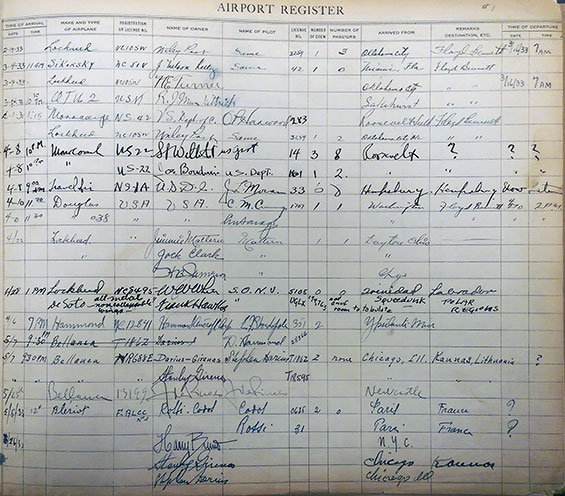 |
If you want to study this page a little more closely, you can download a PDF image of page one of the Floyd Bennett Field Register at the link.
All the entries were made between February 19, 1933 and May 6, 1933. All the months are represented, but there are significant gaps between dates.
DeSoto, 1932 Four-door Sedan (Source: Web
Commons)
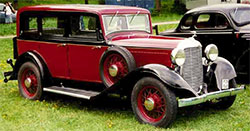 |
Three of the pilots on this page, Post, Mattern and Hawks, were signers of other Registers as well. Sanford Leland Willits was an inspector with the Department of Commerce and showed up as a passenger once with pilot Lee Willey.
In the case of Hawks, it appears he arrived at the Field by automobile (DeSoto) and spoofed the Register by stating that his craft had, "all-metal non collapsable wings." His home base and destination were equally as made-up. His "craft" might have looked like the one at left.
You'll find other obvious spoofs on some other pages below. While amusing, most of them give little insight into aviation history.
PILOTS AND AIRCRAFT SIGNED IN THE FLOYD BENNETT FIELD REGISTER, PAGE 1
| No. |
Last Name, First Name |
Aircraft Make & Registration Number |
Date |
| 1 |
Post, Wiley |
Lockheed NC105W |
February 19, 1933 |
| 2 |
Kelly, James Nelson |
Sikorsky NC51V |
March 4, 1933 |
| 3 |
Turner, H.E. |
Lockheed NC105W |
March 4, 1933 |
| 4 |
Munkittrick, Robert J. |
OTU-2 |
March 24, 1933 |
| 5 |
Harwood, Oren Perry |
Monocoupe 110 NS42 |
April 1, 1933 |
| 6 |
Post, Wiley |
Lockheed NC105W |
|
| 7 |
Willits, Sanford Leland |
Monocoach 275 NS22 |
April 8, 1933 |
| 8 |
Boudwin, Joseph |
Monocoach 275 NS22 |
April 8, 1933 |
| 9 |
Moran, J.L. |
Travel Air NS1A |
April 8, 1933 |
| 10 |
Cummings, C.M. |
Douglas |
April 10,1933 |
| 11 |
Savage, Charles M. |
Douglas O38 |
April 10, 1933 |
| 12 |
Mattern, Jimmie |
Lockheed (NR869E) |
April 22, 1933 |
| 13 |
Clark, Jack |
Lockheed (NR869E) |
April 22, 1933 |
| 14 |
Jameson, H.B. |
Lockheed (NR869E) |
April 22, 1933 |
| 15 |
White, W.W. |
Lockheed NC8495 |
April 28, 1933 |
| 16 |
Hawks, Frank |
DeSoto UGLX |
|
| 17 |
Skocdopole, Erwin F. |
Hammond NC12841 |
April 6, 1933 |
| 18 |
Harmond, Dean |
Pass. With Skocdopole |
May 7, 1933 |
| 19 |
Darius, Steponas |
Bellanca NR688E |
May 7, 1933 |
| 20 |
Girenas, Stasys |
Bellanca NR688E |
May 7, 1933 |
| 21 |
de Pinedo, Francesco |
Bellanca NC13199 |
May 23, 1933 |
| 22 |
Codos, Paul |
Bleriot F-ALCC |
May 6, 1933 |
| 23 |
Rossi, Maurice |
Bleriot F-ALCC |
May 6, 1933 |
| 25 |
Bruno, Harry |
|
|
| 25 |
Girenas, Stasys |
|
|
| 26 |
Darius, Steponas |
|
|
---o0o---
THE REGISTER OF FLOYD BENNETT FIELD, PAGE 2 (Source: COA)
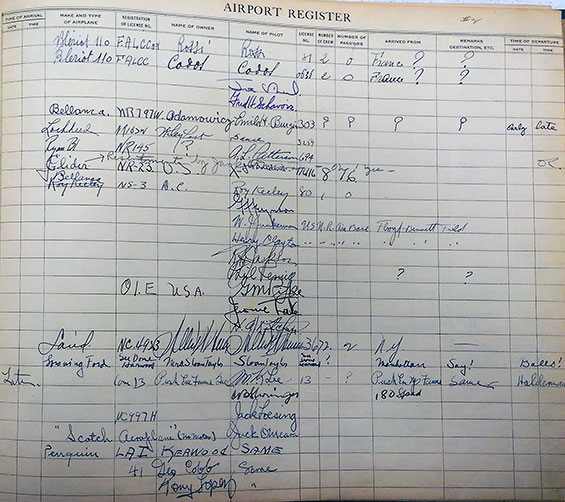 |
If you want to study this page a little more closely, you can download a PDF image of page two of the Floyd Bennett Field Register at the link. Unfortunately there were no dates associated with any of the entries on page two. There are, however, some significant people and airplanes represented.
PILOTS AND AIRCRAFT SIGNED IN THE FLOYD BENNETT FIELD REGISTER, PAGE 2
| No. |
Last Name, First Name |
Aircraft Make & Registration Number |
Date |
| 27 |
Rossi, Maurice |
Bleriot F-ALCC |
|
| 28 |
Codos, Paul |
Bleriot F-ALCC |
|
| 29 |
Unreadable, Joe (Nikrent?) |
|
|
| 30 |
Schavoir, Fred H. |
|
|
| 31 |
Burgin, Emil H. |
Bellanca NR797W |
|
| 32 |
Post, Wiley |
Lockheed NC105W |
|
| 33 |
Patterson, A.L. |
Ryan B1 NR145 |
|
| 34 |
Bouduin, Joseph |
Fairchild (?) NR23 |
|
| 35 |
Keeley, Roy |
Bellanca NS3 |
|
| 36 |
Feynson, G.F. |
|
|
| 37 |
Junkeman, W.J. |
|
|
| 38 |
Clayton, Henry |
|
|
| 39 |
Jackson, R. |
|
|
| 40 |
Remig, Phil |
|
|
| 41 |
Pike, G.M. |
Curtiss O-1E |
|
| 42 |
Tate, Jerome |
|
|
| 43 |
Kitchen, H.A. |
|
|
| 44 |
Unreadable |
Laird NC4923 |
|
| 45 |
Taylor, Sloan |
Ford |
|
| 46 |
Lee, M.K. |
|
|
| 47 |
Unreadable |
|
|
| 48 |
Loesing, Jack |
Fairchild NC997H |
|
| 49 |
O'Meara, Jack |
|
|
| 51 |
Kerwood |
Penguin (Trainer NC11596?) |
|
| 51 |
Cobb, George |
|
|
| 52 |
Lopez, Tony |
|
|
---o0o---
THE REGISTER OF FLOYD BENNETT FIELD, PAGE 3 (Source: COA)
 |
If you want to study this page a little more closely, you can download a PDF image of page three of the Floyd Bennett Field Register at the link. Again, unfortunately, there were no dates associated with any of the entries on page three.
PILOTS AND AIRCRAFT SIGNED IN THE FLOYD BENNETT FIELD REGISTER, PAGE 3
| No. |
Last Name, First Name |
Aircraft Make & Registration Number |
Date |
| 53 |
Galloway, R.W. |
Ford NC7864 |
|
| 54 |
Hawks, Frank |
Northrop NR12265 |
|
| 55 |
Cleveland, Bill |
Sikorsky NC809W |
|
| 56 |
Willits, S.L. |
Monocoach NS22 |
|
| 57 |
Harwood, O. |
Monocoupe NS42 |
|
| 58 |
Levy, Lou |
Kellett Autogiro NC11685 |
|
| 59 |
Weston, J |
Great Lakes NC859K |
|
| 60 |
Gerehise, John |
F32 |
|
| 61 |
Peckinpaugh, George R. |
Douglas M-3 (?) NC1001 |
|
| 62 |
Warren, Jack |
Waco GXE NC3993 |
|
| 63 |
Smithy |
Nicholas-Beazley |
|
| 64 |
Shaughnessy, J. |
|
|
| 65 |
Flynn, Frank S. |
|
|
| 66 |
McAllister, Lt. |
Y1B7 |
|
| 67 |
Kinsey, A. Ward |
Y1B7 |
|
| 68 |
Earhart, Amelia |
|
|
| 69 |
Thaw, Russell W. |
Gee Bee NR2101 |
|
| 70 |
Gehlbach, Lee |
Wedell-Williams NR247V |
|
| 71 |
Nichols, Ruth |
(NC988Y ) Lockheed Orion |
|
| 72 |
McDaniel, A.B. |
Martin XB-10 |
|
| 73 |
Umstead, S.M. |
Lockheed Altair |
|
| 74 |
Mustoe, A. |
Ford C-9 |
|
| 75 |
Price, J.H. |
Ford C-9 |
|
| 76 |
Lee, Thomas |
|
|
Although undated, the appearance of Thaw, Gehlbach and Nichols could be associated with the 1933 Bendix Race.
---o0o---
THE REGISTER OF FLOYD BENNETT FIELD, PAGE 4 (Source: COA)
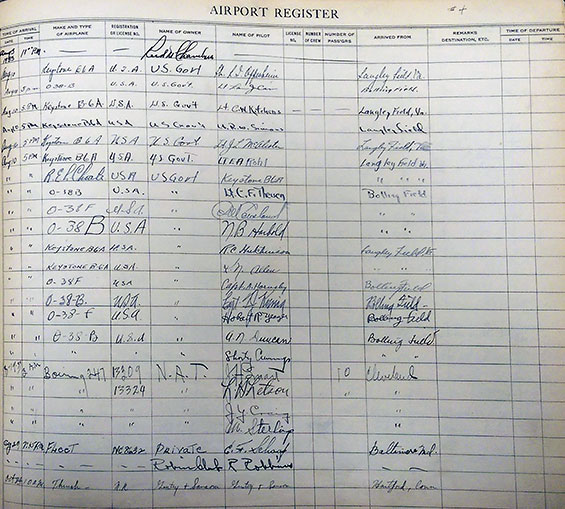 |
If you want to study this page a little more closely, you can download a PDF image of page four of the Floyd Bennett Field Register at the link.
PILOTS AND AIRCRAFT SIGNED IN THE FLOYD BENNETT FIELD REGISTER, PAGE 4
| No. |
Last Name, First Name |
Aircraft Make & Registration Number |
Date |
| 77 |
Chambers, Reed |
|
August 3, 1933 |
| 78 |
Oppenheim, L.I. Lt. |
Keystone B-6A |
August 10, 1933 |
| 79 |
Cain, Louis J. Lt. |
O-38B |
August 10, 1933 |
| 80 |
Kitchens, C.W. Lt. |
Keystone B-6A |
August 10, 1933 |
| 81 |
Simons, R.W. Lt. |
Keystone B-6A |
August 10, 1933 |
| 82 |
McAlister, J.L. Lt. |
Keystone B-6A |
August 10, 1933 |
| 83 |
Rohl, E.A. Lt. |
Keystone B-6A |
August 10, 1933 |
| 84 |
Choate, R.E.L. |
Keystone B-6A |
August 10, 1933 |
| 85 |
Theisen, C.F. Lt. |
O-38B |
August 10, 1933 |
| 86 |
Cousland, C.W. |
O-38F |
August 10, 1933 |
| 87 |
Harbold, N.B. |
O-38B |
August 10, 1933 |
| 88 |
Hutchinson, R.C. |
Keystone B-6A |
August 10, 1933 |
| 89 |
Allen, K.N. |
Keystone B-6A |
August 10, 1933 |
| 90 |
Hornsby, A. Capt. |
O-38F |
August 10, 1933 |
| 91 |
Koenig, T.J. Capt. |
O-38B |
August 10, 1933 |
| 92 |
Yeager, Hobart R. |
O-38F |
August 10, 1933 |
| 93 |
Duncan, A.N. |
O-38B |
August 10, 1933 |
| 94 |
Cummings, Shorty |
O-38B |
August 10, 1933 |
| 95 |
Smart, J.H. |
Boeing 247 NC13309 |
August 19, 1933 |
| 96 |
Letson, L.D. |
Boeing 247 NC13329 |
August 19, 1933 |
| 97 |
Craig, J.Y. |
Boeing 247 NC13329 |
August 19, 1933 |
| 98 |
Sterling, M. |
Boeing 247 NC13329 |
August 19, 1933 |
| 99 |
Schaaf, E.F. |
Fleet NC8623 |
August 20, 1933 |
| 100 |
Robbins, R. |
|
August 20, 1933 |
| 101 |
Gentry, Viola & Sansome, Mary |
Curtiss Thrush NR |
October 26, 1933 |
---o0o---
THE REGISTER OF FLOYD BENNETT FIELD, PAGE 5 (Source: COA)
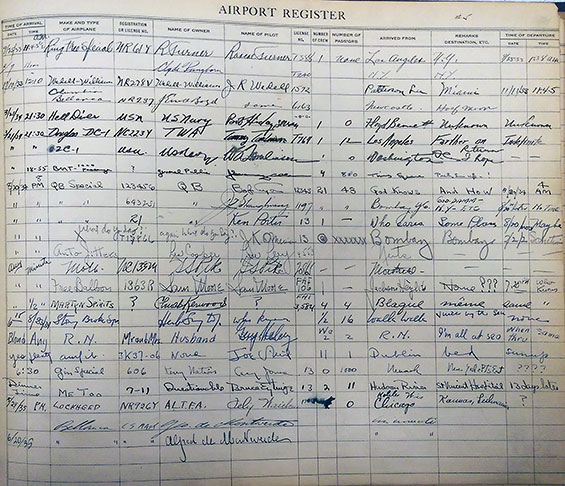 |
If you want to study this page a little more closely, you can download a PDF image of page five of the Floyd Bennett Field Register at the link.
PILOTS AND AIRCRAFT SIGNED IN THE FLOYD BENNETT FIELD REGISTER, PAGE 5
| No. |
Last Name, First Name |
Aircraft Make & Registration Number |
Date |
| 102 |
Turner, Roscoe |
NR61Y Ring Free Special |
September 25, 1933 |
| 103 |
Pangborn, Clyde |
|
|
| 104 |
Wedell, J.R. |
NR278V Wedell-Williams |
November 10, 1933 |
| 105 |
Boyd J.E. |
Bellanca NR237 |
|
| 106 |
Hiday, Bob |
Hell Diver |
March 21, 1934 |
| 107 |
Tomlinson, Tommy |
Douglas DC-1 NC223Y |
March 21, 1934 |
| 108 |
Tomlinson, W.B. |
O2C-1 |
March 21, 1934 |
| 109 |
Spoof |
|
March 21, 1934 |
| 110 |
Spoof |
|
August 20, 1934 |
| 111 |
Spoof |
|
August 20, 1934 |
| 112 |
Spoof |
|
August 20, 1934 |
| 113 |
Spoof |
|
August 20, 1934 |
| 114 |
Spoof |
|
August 20, 1934 |
| 115 |
Pike, S.S. |
DH Moth NC133M |
|
| 116 |
Moore, Sam |
NC1363R(0) Thompson Balloon |
August 20, 1934 |
| 117 |
Kerwood, Chuck |
|
August 20, 1934 |
| 118 |
Spoof |
|
|
| 119 |
Spoof |
|
|
| 120 |
Unreadable, Joe (Nikrent?) |
|
|
| 121 |
Spoof |
|
|
| 122 |
Spoof |
|
|
| 123 |
Waitkus, Felix |
Lockheed NR926Y |
May 24, 1935 |
| 124 |
deMonteverde, George |
Bellanca C-? |
|
| 125 |
deMonteverde, Alfred |
Bellanca C-? |
June 20, 1935 |
---o0o---
Like I said above, we have (so far) only these five pages known to exist of the Register of Floyd Bennett Field. That there were others is certain, because the following image, from an article that appeared in the December, 1938 issue of Popular Aviation (PA), page 13, shows a segment of a Floyd Bennett Field Register page dated July 15-18, 1938. Notice the difference in masthead compared to the sheets above. This makes it clear there was more than one book or more than one set of blank Register sheets. The categories of information are different also.
Popular Aviation, December, 1938 (Source: PA)
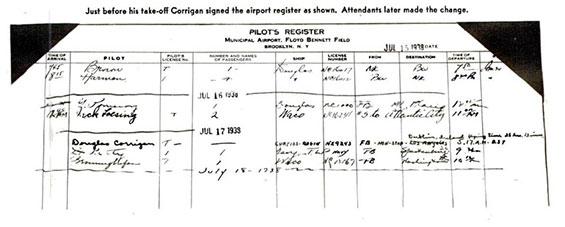 |
This PA article featured the flight of Douglas "Wrong Way" Corrigan, whose signature is visible on July 17, 1938, above. The article began on page ten at the link. So I say again...
IF YOU KNOW THE LOCATION OF ANY MORE FLOYD BENNETT FIELD REGISTER PAGES, PLEASE LET ME KNOW!
MORE ABOUT THE REGISTER Below is the cover of the book. It is a simple, leather-bound, loose-leaf document with two holes with screws through the holes.
THE REGISTER OF FLOYD BENNETT FIELD, COVER (Source: COA)
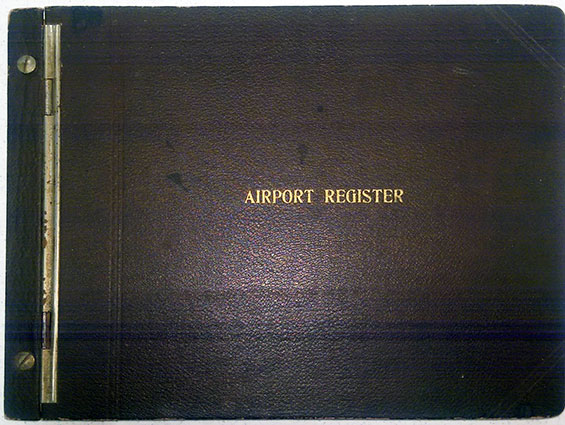 |
Below is the view as you open the book. There is no frontispiece. Rather the book begins with the first page exhibited above. I've presented this image length-wise for better visibility. Four other signature pages followed this one, as exhibited above.
THE REGISTER OF FLOYD BENNETT FIELD, INSIDE COVER (Source: COA)
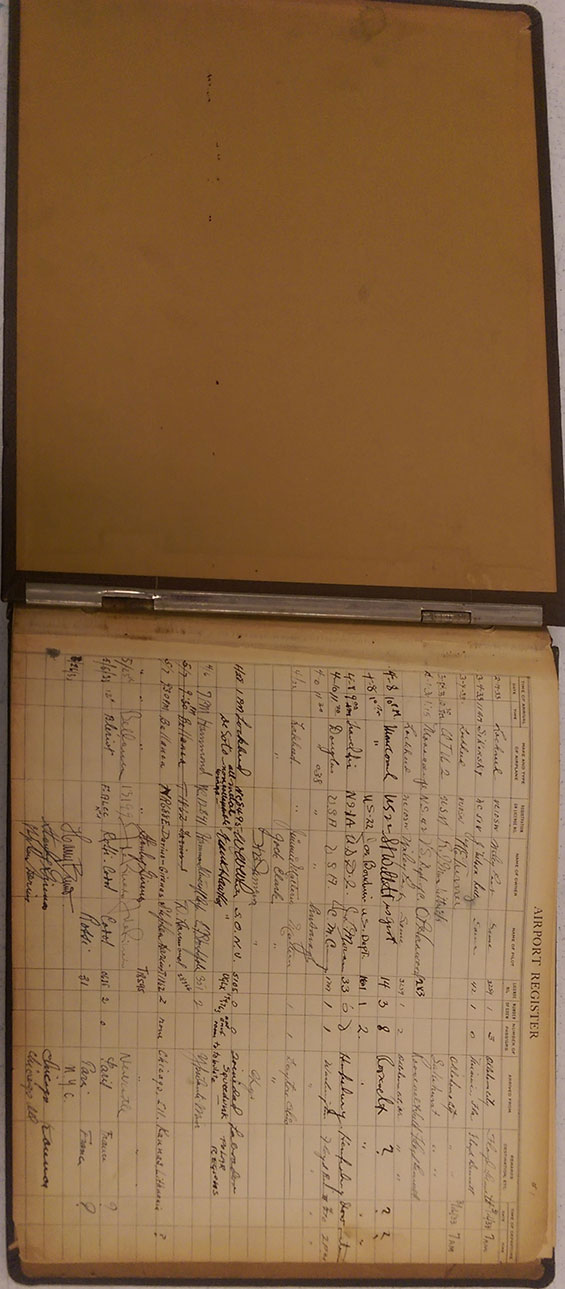 |
I'm looking for information and photographs of all the entities on these pages. If you can help, please let me KNOW. Likewise, if you know of the location of any airport Register, regardless of geographical location, that looks like the pages above, please let me know.
IF YOU KNOW THE LOCATION OF ANY MORE FLOYD BENNETT FIELD REGISTER PAGES, PLEASE LET ME KNOW!
---o0o---
CHRONOLOGY OF NOTABLE FLIGHTS AT FLOYD BENNETT FIELD
The box below contains a list of special flights that either originated or ended at Floyd Bennett Field from 1930-1939. The list appeared on the National Park Service Web site at the link. You will note the names of many Register pilots and passengers, including the airfield's namesake, Floyd Bennett. I have identified and/or linked them.
Record - setting and Famous Flights From Floyd Bennett Field (also, known as Naval Air Station - New York,) 1930 - 1957
Note: This is NOT a complete list of all flights.
June 26, 1930
Although unfinished and with major construction continuing throughout the ceremony, Floyd Bennett Field received its first dedication. Floyd Bennett's widow, Mrs. Cora Bennett and Lieut. Comdr. Richard E. Byrd were present at the event which featured a flyby by the Army Air Corps and a visit by the Navy dirigible Los Angeles. Flight operations began at FBF after the dedication.
May 23, 1931
Floyd Bennett Field's formal dedication ceremony was marked by a flyby of 672 U.S. Army aircraft. Presided over by N.Y. Mayor James J. Walker, the event drew some 25, 000 spectators. Eight Navy planes commanded by [Register pilot] Lieut. R.F. Whitehead were the first aircraft to arrive officially at the field
July 28-30, 1931
Russell N. Boardman and John Polando in the monoplane "Cape Cod", establish a distance record of 5,011.8 miles without refueling in their flight, mostly on instruments, from Floyd Bennett Field to Istanbul, Turkey (49:20:00, Bellanca CH, Wright J-6 engine) . This flight breaks the previous record of 4,912 miles set by Costes and Bellonte flying from Paris to Coulart, China in 1930.
July 28-29, 1931
Hugh Herndon and Clyde Pangborn in their plane Miss Veedol fly to Moylegrove, Wales (31:42:00, Bellanca Skyrocket, Pratt & Whitney Wasp engine) from FBF on the first leg of a round-the-world flight. The two had taken off from FBF 17 minutes later than the Cape Cod and were out to break the globe circling record set by Wiley Post and Harold Gatty. Delays due to bad weather and need for repair caused them to fall far behind schedule. They decided to fly to Tokyo and try for the first nonstop crossing of the Pacific which brought with it a $25,000 prize offered by the newspaper Tokyo Asahi. They had radioed ahead to Japan for permission to land at Tokyo but took off before they received a reply. In Tokyo they were arrested for flying over and photographing military installations. They were held by the military and questioned for a number of weeks, tried, fined $1,025 and granted permission to leave the country by air. However, they were allowed only one chance for take off. If that failed they would have to leave by ship.
On October 3rd they took off from Samishiro Beach, north of Tokyo. In the air Herndon cut a wire to jettison the plane's landing gear, reducing the load by 300 pounds. At Wenatchee, Washington the aircraft landed on its belly, sliding along in a cloud of sparks and dust, the pilots unhurt. Waiting for them on the field was a representative from the Japanese newspaper with a check for $25,000.
October 17, 1931
Hugh Herndon and Clyde Pangborn complete the round the world flight begun in July setting a record for the longest non-stop flight to date in a first trans-Pacific crossing (4,558 miles in about 41 hours). Having installed a new landing gear and propeller on their plane the two pilots crossed the country in easy hops, timing their arrival at FBF for a Four-Field Flying Show staged as a benefit for New York's unemployed by the aviation industry.
December 10, 1931
The Herbert Shiff Memorial Trophy is awarded to the U.S. Naval Reserve Aviation Base at Floyd Bennett Field for the aircraft squadron or unit flying the greatest number of hours during the year without serious accident.
February 1, 1932
Ruth Nichols flying from FBF sets an altitude record for oil (diesel motors) burning planes, of 19,928 feet (Packard Lockheed monoplane).
June 3, 1932
Stanislaus F. Hausner rescued by a British tanker eight days after his plane was forced down in the Atlantic in an aborted attempt to make a solo trans-oceanic flight (Bellanca Pacemaker, Wright Whirlwind engine).
July 5-6, 1932
James Mattern and Bennett Griffin, starting from FBF fly non-stop from Harbor Grace, Newfoundland to Berlin, Germany in their attempt to fly around the world. They continued to Borisov, Russia. (18:41:00, Lockheed Vega, Pratt & Whitney engine.)
August 25-September 11, 1932
George Hutchinson and Family attempt trans-Atlantic flight but had to make a forced landing off the coast of Greenland. They were rescued by a British trawler two days later (Sikorsky amphibian, two Pratt & Whitney motors).
August 29, 1932
James C. Haizlip establishes a transcontinental record from Burbank, California to FBF during the Bendix Trophy Race (10:19:00, Wedell-Williams, Pratt & Whitney Wasp Jr. engine).
August 29, 1932
Roscoe Turner arrives shortly after Haizlip from Los Angeles (10:58:39, Wedell-Williams, Pratt & Whitney Wasp Jr. engine)
September 13, 1932
William Ulbrich with co-pilot Edna Newcomber and passenger/medical observer Dr. Leon Pisculli, are lost at sea in an attempted trans-Atlantic crossing from FBF to Rome. (Bellanca Skyrocket, named "American Nurse" Pratt & Whitney Wasp engine).this attempt to conquer the Atlantic was made for the purpose of collecting medical data on the effects of a protracted and hazardous flight on the human system.
November 14, 1932
Roscoe Turner fighting westerly winds establishes a new East-West record from FBF to Burbank (12:33:00, Wedell-Williams, Pratt and Whitney engine).
June 2, 1933
Lt. Comdr Frank Hawks in his Sky Chief establishes a new West-East non-stop record, from Los Angeles to FBF (13:26:15, Northrop Gamma, Wright Whirlwind R-1510 engine)
June 3, 1933
James J. Mattern attempts the first solo around-the-world flight, making it across the Atlantic to be forced down in Siberia on June 15th. After 14 days on the banks of the river Anadyr he was rescued by Eskimos. He had broken his ankle in the crash. What food he had with him, a small supply of chocolate and biscuits lasted five days. Later, he flies part of the way back to New York (Lockheed Vega, Pratt & Whitney engine).
June 4, 1933
Henrietta Sumner of Los Angeles wins the second annual Annette Gipson All-women Air Race at FBF. A crowd of more than 50,000 watched as "23 leading aviatrices [sic] competed in this 40-mile race for $850 first prize." Amelia Earhart was the race Starter and Ruth Nichols the Chief Scorer. Frances Marsalis came in second, Jessamine Goddard third, and Mary Sansome fourth.
June 11-12, 1933
Capt. J. Errol Boyd with Harold P. Davis and Robert G. Lyon fly from FBF to St. Marc, Haiti in the eight year-old Columbia a veteran of long distance nonstop flights including two crossings of the Atlantic -- carrying [Clarence] Chamberlin and Levine to Germany in 1927 and Boyd and Connor to England in 1930 (about 24 hours, Bellanca monoplane, Wright-Whirlwind engine).
July 1, 1933
The Bendix Trophy Race starts from FBF. Winner Roscoe Turner establishes new East-West record from FBF to Los Angeles (11:30:00, Wedell-Williams, Pratt & Whitney engine) . other entrants in the race are James Wedell, Russell Boardman, Lee Gehlbach, Russell Thaw, Amelia Earhart Putnam, and Ruth Nichols.
July 15-17, 1933
Capt. Stephen Darius and Lieut. Stanley Girenas fly from FBF to Lithuania but are killed when their plane crashes in Soldin, Germany just a few miles short of their goal, Kaunas, Lithuania (Bellanca, Wright-Whirlwind engine).
July 15-22, 1933
Wiley Post
in the Winnie Mae makes the first solo round-the-world flight, 15,957 miles, landing at FBF to a welcome by an estimated 50,000 people (7 days 18:45:5, Lockheed Vega, Pratt & Whitney Wasp engine).
"There were hours when I was forced to fly absolutely blind or above the clouds. It was called a solo flight, but I never could have made the record without the efficient little co-pilot -- the Sperry Pilot for automatic flying. Without it, the strain of flying through the worst weather I ever saw would have been too great." - Wiley Post
July 19-25, 1933
Air Marshall Italo Balbo of the Italian Air Force lands at Floyd Bennett Field with his flotilla of 24 seaplanes. He had flown on a goodwill mission to the Century of Progress Exhibition (Chicago World's Fair) from Italy via Iceland and Labrador, losing two planes on the way. The longest, seven days, stop of the squadron was an occasion to meet with the Italian community in New York as well thoroughly overhaul the flying boats in preparation for their journey back to Italy. (Savoia-Marchetti S-55X, two Isotta Fraschini Asso motors).
From the Aircraft Yearbook "July 1-Aug.12 General Orbetello, Italy with 25 seaplanes of the Italian Air Force, flies to Chicago, Ill., via Iceland and Labrador, 23 of the planes returning to Rome via New York, Newfoundland, and the Azores."
August 5-7, 1933
Lieut. Maurice Rossi and Paul Codos fly their plane Joseph Lebrix from FBF to Rayak, Syria to establish a distance record of 5,657.387 miles (in about 55 hours). Loaded down with 1, 770 gallons of gasoline the aircraft used nearly all of the 4,200-foot runway at the field to gain airspeed (Bleriot 110, Hispano-Suiza engine.)
August 8, 1933
The brothers Benjamin and Joseph Adamowicz take off from FBF in a proposed flight to Warsaw, Poland. They had to abandon their attempt after their plane was badly damaged while landing at Harbor Grace, Newfoundland on the first leg of the trip.
September 2, 1933
Former Chief of Staff of the Royal Italian Air Force, General Francesco de Pinedo was killed trying to take off from FBF in an attempt to set a solo distance record of 7,500 miles from New York to Baghdad, Iraq.
"The wheels of the big Bellanca the "Santa Lucia," never left the ground. The plane swerved over the wide, long runway, bumped across 500 feet of uneven turf and tore through a steel fence which snapped off one of the broad wings and the whirling prop and burst into flames.
"Horrified but helpless witnesses saw Marquis de Pinedo stand in the cockpit of his plane as if trying to cut the switch a moment before its orange-red wings were engulfed in flames. After that . there was nothing any one could do and de Pinedo perished in the fire." -- Newspaper Account
September 25, 1933
Roscoe Turner sets new trans-continental record in flight from Burbank to FBF averaging 250 miles per hour (10:04:55, Wedell-Williams, Pratt & Whitney Wasp engine).
April 25, 1934
Laura H. Ingalls arrives at FBF after completing a 17,000 mile flight to South America, flying alone since her departure on February 28th from Glen Curtiss Airport, North Beach [later LaGuardia Field] (Lockheed Air Express, Pratt & Whitney Wasp engine).
May 14-15, 1934
George R. Pond and Cesare Sabelli fly from FBF to Lahinch, Ireland, continuing on to their planned destination, Rome (32 hours, approx. , Bellanca Pacemaker, Wright Whirlwind engine).
May 27-28, 1934
Paul Codos and Maurice Rossi complete the second non-stop airplane crossing from Continental Europe landing at FBF. The flight which began in Paris was an attempt to beat their non-stop distance record of 5, 657 miles, New York to Syria in 1933 with a planned destination of Los Angeles. They reported the strain of carrying 12,540 pounds of gasoline was beyond the capability of their veteran plane and they had to land in New York (38:27:00, Bleriot 110, Hispano-Suiza engine).
June 28, 1934
Adamowitz Brothers leave from FBF in a second attempt to fly to Poland. After forced landings at Saint André de Messei and Nedlitz-Thermendorf, Germany, they reached Warsaw on July 2nd.
September 1, 1934
Roscoe Turner arrives at FBF from Burbank, California to set a new transcontinental record (10:02:57, Wedell-Williams, Pratt & Whitney Hornet engine).
January 15, 1935
James Doolittle arriving from Burbank, California, with his wife, Josephine, and one other passenger, sets a transcontinental nonstop record for a passenger transport aircraft (11:59:00, Developmental Vultee, Wright Cyclone engine).
"With any kind of flying weather the trip could have been made in considerably less time. We flew at least 300 miles out of the way. The steady northwest: wind drifted us far south of our course. Several times I used a knife to try to scrape the ice from the windshield but didn't have much success with this. occasionally the moon would come out through the clouds but for the most part everything was blackness around us." -- James Doolittle
February 20-21, 1935
[Register pilot] Leland S. Andrews with Henry Meyers, co-pilot, and G.D. Rayburn, radio operator breaks Doolittle's transcontinental passenger plane speed record, arriving from Los Angeles at FBF in an American Airlines plane (11:34:16, Developmental Vultee, Wright Cyclone engine).
April 30, 1935
Comdr. D.W. Tomlinson with H.B. Snead and Peter Redpath in a Transcontinental and Western Air (TWA) plane sets nonstop record from Burbank to FBF (11:05:45, Douglas DC-1, two Wright Cyclone engines).Flying 80 percent of the time guided by instruments -- the Sperry gyropilot -- they were helped to a speed of 280 miles per hour with a high tail wind and the three-mile-high layer of light air through which they were flying. one minute before eight p.m., New York time they streaked across the field, too high and too fast to make an approach. Tomlinson had to take the plane ten miles out over the Atlantic ocean and turn back while slowing down and losing enough altitude to land.
May 16-17, 1935
Comdr. D.W. Tomlinson and J.S. Bartles in demonstrating increased ability of modern transport planes and engines to carry heavy loads, set 14 speed records at FBF (Douglas DC-1, two Wright Cyclone engines).
May 18, 1935
D.W. Tomlinson and J.S. Bartles establish eight more speed records for passenger transport airplanes (Douglas DC-1, two Wright Cyclone engines).
July 11, 1935
Laura H. Ingalls sets east-west speed record for women with a non-stop flight from FEF to Burbank (18:23:00, Lockheed Orion, Pratt &: Whitney Wasp engine).
July 18-August 16, 1935
Thor Solberg with radio operator Paul Oscanyan leaves FBF for Bergen, Norway by way of Canada, Greenland, and Iceland (Loening Amphibian, Wright Cyclone engine).
August 24, 1935
Major General Frank M. Andrews, U.S. Army, J.G. Moran, and H.O. Johnson, make three seaplane speed records for 1,000 km of 165.040 mph at Floyd Bennett Field , Brooklyn, New York. (Martin B-12-A, 2 Pratt and Whitney Hornet engines).
September 12, 1935
Laura H. Ingalls sets a west-east record for women flying from Burbank to FBF breaking the 17 hour seven minutes record set by Amelia Earhart (13:34:05, Lockheed Orion, Pratt & Whitney Wasp engine).
"My radio went out of order west of Columbus when I needed it most. I found myself flying on the wrong beam and so I just turned east and came on." -- Laura Ingalls
September 20, 1935
Capt. Eddie Rickenbacker flying the first Lockheed Electra received by Eastern Airlines made a record flight from Kansas City, Mo. to FBF.
September 21-22, 1935
[Register pilot] Lieut. Felix Waithus (Feliksas Vaitkus) takes off from FBF on a projected flight to Lithuania but is forced down in Ballinrobe, Ireland (23:15 Lockheed Vega, Pratt & Whitney Wasp engine).
April 21, 1936
Howard Hughes lands at FBF after setting a new intercity speed record from Miami (04:21:32, Northrop Gama, Wright Cyclone engine).
September 2-21, 1936
Henry T. ("Dick") Merrill and Harry Richman in the Lady Peace are forced down in Llwyncelny, Wales during an attempt to be the first to fly from FBF to London and return (18:38, Development Vultee, Wright G Cyclone engine). They made the return trip via Newfoundland leaving Southport Beach, England on September 14 and arriving at FBF on September 21.
September 4, 1936
Louise Thaden and Blanche Noyes win the Bendix Trophy Race from FBF to Burbank, California, setting a new women's east-west transcontinental record (14:55:01, Beechcraft, Wright Whirlwind engine). Other participants were: Laura Ingalls, Joe Jacobson, George Pomeroy, Amelia Earhart, Benny Howard, William Warner.
September 4-5, 1936
Mrs. Beryl Markham flies from Abingdon, England, to Baleine, Nova Scotia, on an attempted flight to New York, in 24 hours, 30 minutes. (Percival Vega Gull, DeHavilland Gypsy engine.)
September 21, 1936
Mrs. Beryl Markham arrives at Floyd Bennett Field to complete the first solo flight from Europe to America. She had been forced down in Sydney, Nova Scotia damaging her plane. Floyd Bennett Field was her original destination
October 6-7, 1936
After taking off from FBF on a projected flight to Stockholm, Sweden Kurt Bjorkvall crash lands in the Atlantic 100 miles west of Ireland. He was rescued by a French trawler.(NOTE: Bellanca Pacemaker, Pratt and Whitney Wasp engine)
October 28-30, 1936
[Register pilot] Capt. James A. Mollison flies non-stop from FBF to Croydon Airport, London establishing a new record for the segment over the Atlantic from Harbor Grace, Newfoundland to England (13:17, Bellanca Flash, Pratt & Whitney Wasp engine).
December 13, 1936
Maj. Alexander de Seversky attempts non-stop flight from FBF to Havana but is forced down in Miami by bad weather. Later, he sets a new record for flights by amphibians between Miami and Havana (Seversky Amphibian).
December 14, 1936
Maj. Alexander P. de Seversky sets new speed record between FBF and Miami (5:46:30, Seversky Sev 3, Wright Cyclone engine).
May 9, 1937
1st Lieut. H.M. McCaffrey piloting a new U.S. Army amphibious plane from FBF made a trial flight to Miami with eight military passengers (Douglas Amphibian, YOA-3317)
May 9, 1937
Dick Merrill and co-pilot Jack Lambie fly to Croydon airport, London to bring back photographs of the Coronation of King George VI (20:59:00, with a stop in Essex to get their bearings. (Lockheed Electra, two Pratt & Whitney Twin Wasp engines).
May 14, 1937
Dick Merrill and John Lambie land at FBF after setting a new record for the westward crossing of the Atlantic (24:22:25, including landing at Squantum, Mass. to check gas, Lockheed Electra, two Pratt & Whitney Twin Wasp engines).
May 23, 1937
1st Lieut. Bentley and 2nd Lieut. Morgan with a crew of seven arrive at FBF in the prototype heavy coastal defense bomber. "The ship was placed on display for a large Sunday crowd and at about 5:00 PM departed for Langley Field, Va. (Boeing YB-17, Flying Fortress, four engines).
September 3, 1937
Frank Fuller, arriving from Los Angeles, sets a new Bendix transcontinental record (09:44:30, Seversky R70Y).
October 22, 1937
Sir Hubert Wilkins and co-pilot Herbert Hollick-Kenyon fly to Winnipeg, Canada on the first leg of a continued search for Soviet fliers lost in the Arctic (Lockheed Electra, fitted with skis in Canada).(Aviation Yearbook)
November 20, 1937
An air parade was held at Floyd Bennett Field in memory of Amelia Earhart who had disappeared earlier in the year over the Pacific ocean. Civilian planes joined those from the Navy, Coast Guard and Army in the fly by. (Aviation Yearbook)
December 3, 1937
Jacqueline Cochran
sets a non-stop record from FBF to Miami, Florida (4:12:30, Seversky Executive X18y).
December 3, 1937
Alexander de Seversky sets record for non-stop flight from FBF to Havana, Cuba (05:03:00, Seversky P-35) . (Aviation Yearbook)
July 4, 1938
Howard Hughes is greeted by several thousand people when he arrives at FBF to begin preparations for his round-the-world flight.
July 10-14, 1938
Howard Hughes, pilot, with Harry P.M. Connor and Lieut. Thomas Thurlow, navigators, Richard Stoddart, radio engineer, and Ed Lund, flight engineer, make record round-the-world flight in the plane named The New York World's Fair, 1939. In addition to maintaining radio contact with the fair, the flight conducted tests of long range flying with new navigational equipment. The 14,791-mile route went from New York to Paris, Moscow, Omsk, Yakutsk, Fairbanks, Minneapolis, New York (3 days 19:08:10, Lockheed 14 monoplane, two 1,100-horsepower Wright Cyclone engines).
July 17-18, 1938
Douglas "Wrong Way" Corrigan [see above] , after filing a flight plan to go from Floyd Bennett Field to the West Coast, and in an airplane not certified to fly over water, flies 3,150 miles to Baldonnel Airport, Dublin, Ireland. He noted as his panel compass was broken he navigated by one placed on the floor of the plane. In two hours he flew over a city he thought was Baltimore but proved to be Boston (28:13, Curtiss Robin, 175-horsepower Wright Whirlwind, J-6 engine).
August 10-11, 1938
Alfred Henke, Rudolf von Moreau, Paul Dierberg, and Walter Kober make record crossing from Berlin, Germany, to FBF, returning August 13-14. originally planned as a round-the-world flight until the Howard Hughes feat they decided to attempt the distance-speed record for the North Atlantic. (24:50:12 east-west, 19:55:01 west-east, Focke-Wulf FW 200, four BMW Hornet engines).
August 20. 1938
At 8:53 A.M. Howard Hughes and a crew of three landed at Floyd Bennett Field in his Lockheed "15" airplane on a non-stop flight from Glendale, California. A new transport record of 10 hours and 32 minutes was set on this flight.
August 29, 1938
At 7:37 A.M. Major Alexander de Seversky took-off in a Seversky airplane on a transcontinental flight to Burbank, California. A new record was set on this flight. 10 hr 3 min. (Seversky Pursuit, Pratt and Whitney Twin Wasp engine).
September 3, 1938
Jacqueline Cochran
sets the women's west-east transcontinental record flying from Burbank to Floyd Bennett Field (10:27:55, Seversky, Pratt & Whitney Twin Wasp engine).
May 24, 1939
[Register pilot] Francesco Sarabia flies from Mexico City, 2,350 miles in record time to beat that set by Amelia Earhart of 14:19:00 on May 8th, 1935 (10:40:00, Gee Bee Racer). |
If you want to review some then and now photographs of Floyd Bennett Field, this link to a blog has some nice shots. Please let me KNOW if the link becomes inoperative.
---o0o---
UPLOADED: 10/23/08 REVISED: 03/08/17
|












